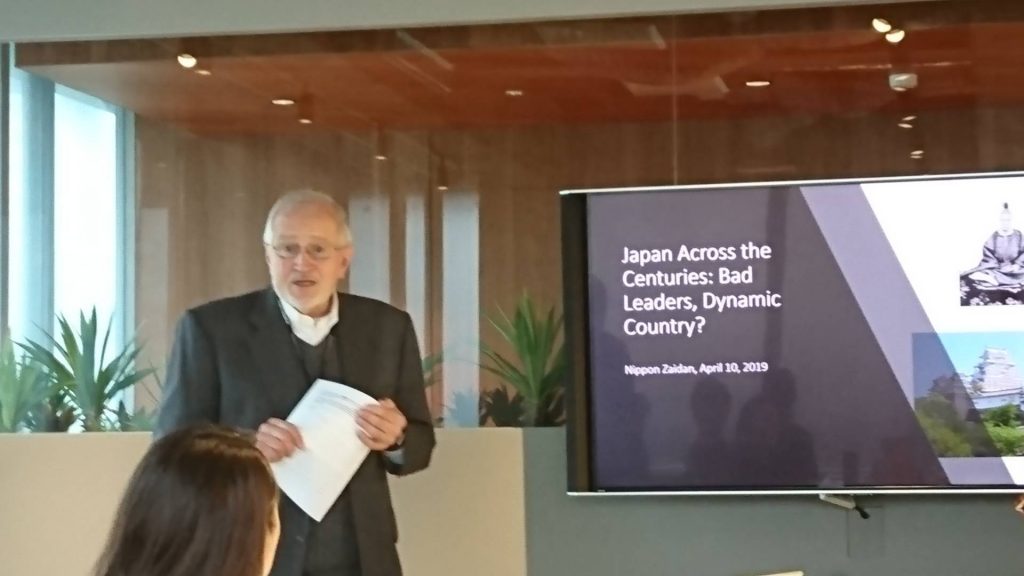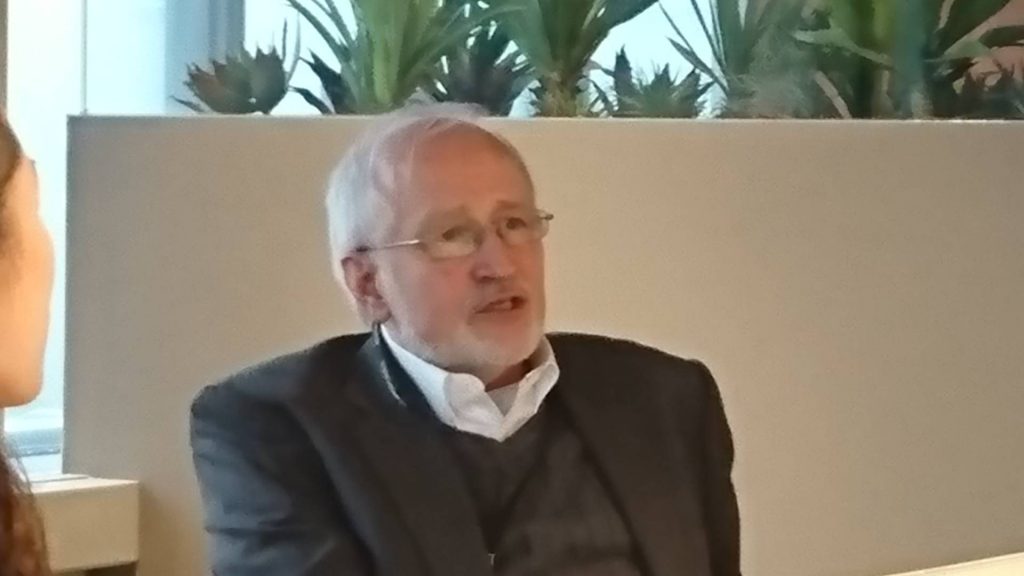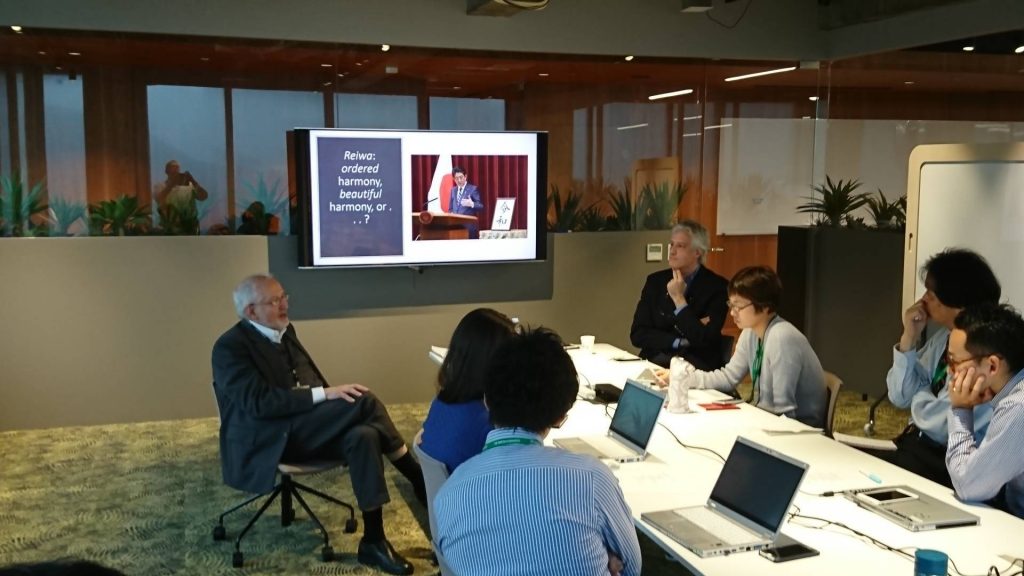A Different Approach to Japanese HistoryInternal seminar for The Nippon Foundation staff
An internal seminar for The Nippon Foundation staff was held at the Foundation’s headquarters in Tokyo on April 10. Dr. James L. Huffman, H. Orth Hirt Professor of History Emeritus at Wittenberg University in Springfield, Ohio, in the United States was invited to speak, and chose as his topic, “Bad Leaders, Dynamic Nation: Lessons from Japanese History.” The seminar was held in English to give Foundation staff an opportunity to use and improve their English skills in an informal setting apart from their ordinary work.

Dr. Huffman began by describing Japan’s history as having had periods of rapid progress, followed by a plateau until the next period of rapid change. In addition, even during those periods of rapid change, political leaders typically have been characterized as weak and inept, yet the country has nevertheless achieved significant progress in areas like the arts and commerce. As examples, he pointed to the Heian Period (794-1185), the Muromachi Period (1333-1573), and contemporary Japan.
The Heian Period saw a succession of weak emperors and a gradual transfer of actual power to regents who ruled in the name of the emperor but were not accountable to them. Nevertheless, it was this period that produced classic literary works including the “Pillow Book” by Sei Shonagon, the “Tale of Genji” by Murasaki Shikibu, which is recognized as one of the world’s first novels, and the “Kokinshu” anthology of poetry. This period also produced the Toba Scrolls, which are considered to be among the world’s first cartoon art.
The Muromachi Period was characterized by internal strife as the Ashikaga family ruled as shoguns from Kyoto, but fought among themselves over succession. This culminated with the 10-year Onin War that left Kyoto in ruins, and led to the Warring States (Sengoku) Period, when actual power devolved to regional samurai leaders who fought among themselves. It was also during this period, however, that many masterpieces of Japanese art were created, including temples and gardens that are still popular tourist attractions today, as well as arts related to Zen Buddhism like ikebana flower arrangement and the tea ceremony. In addition, the period saw vigorous local governments and the rise of agriculture and commerce. The later years of the period also saw the emergence of popular culture like Kabuki theater and ukioe woodblock prints.
Moving to contemporary Japan, in 1989, shortly before the bursting of the economic bubble, Dutch journalist Karel Van Wolferen published “The Enigma of Japanese Power,” in which he argued that Japanese policymaking takes place within a vacuum of centralized leadership. The years after the bubble burst are often referred to as Japan’s “lost decade,” but once again, the 1990s were a time of great entrepreneurial spirit, with more than 1,000 startups going public during the decade from 1993 to 2002. Visitors to Japan at the time were surprised by the dynamism they saw, which contrasted sharply with the gloomy situation they had expected. In the arts, this time also saw Japanese anime gain global popularity.
How, then, do we account for this apparent divergence between weak political leadership and strong cultural and commercial achievement? Dr. Huffman suggested that perhaps not having a core could be seen as a strength rather than a weakness, and identified four aspects of life throughout Japanese history that he sees driving this process.
First, Japan values the work ethic; work is highly valued by society and a person is looked down on if they do not work. This can be traced all the way back to the seventeen-article constitution attributed to Shotoku Taishi of the late sixth and early seventh century, which stated that government ministers should arrive at work early and leave late. Dr. Huffman also noted that during the Meiji Period, people who lived in what today would be called slums nevertheless worked long hours with very few days off.

The second point is that despite the general analysis of Japan being an insular country, in each of the periods mentioned there were significant people who were very pragmatic and open to things from outside. Missions to China in the early seventh century introduced Buddhism and the Chinese character-based kanji writing system to Japan, and 1,000 years later Sakamoto Ryoma, despite being part of the sonno-joi (revere the emperor; expel the barbarians) movement, realized that attempting to keep foreigners out of Japan was futile, and decided instead to study the West and use this knowledge to Japan’s benefit. Among other accomplishments, he is credited with the creation of the Japanese navy in the mid-19th century.
The third point is the existence of a strong sense of initiative and agency at the local level in Japan. These local efforts were often led by people Dr. Huffman describes as “almost outsiders,” who considered themselves outsiders but had sufficient connections within the system to bring about change. The fourth point is the importance placed on education. Both of these can be traced back to the Sengoku Period, when local governments took it upon themselves to build roads, temples acted as predecessors of modern banks, and the existence of some 10,000 private schools led to a rapid spread in literacy. By the early 19th century, Japan probably had the world’s highest literacy rate, because of the private education system, and in 1872 Japan became the first country in the world to introduce compulsory education.
Dr. Huffman’s presentation was followed by a question and answer session, during which he and the attendees discussed how these lessons and patterns apply to Japan today, and how they may be applied to the work of The Nippon Foundation.

Contact
Communications Department
The Nippon Foundation
- Email: cc@ps.nippon-foundation.or.jp



